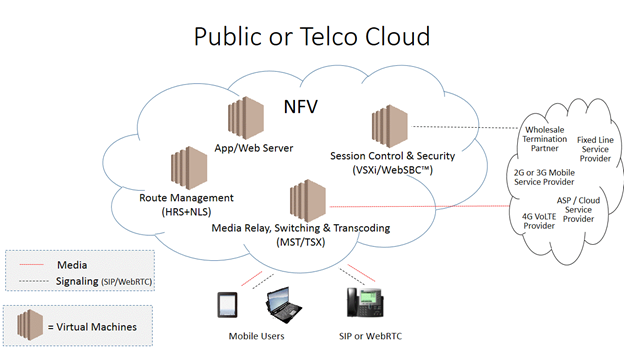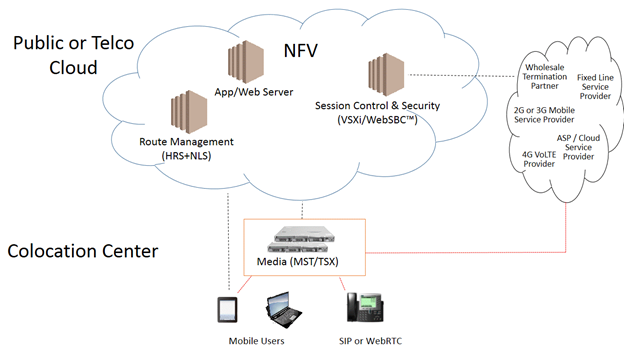Network-Wide NFV Architecture
Sansay’s visionary product line was designed from day one to run on COTS Intel based servers and Linux O/S, and provides the utmost in reliability and performance particularly when faced with traffic surges, network contention, and D/DoS attacks. In addition, the native support for Intel/COTS hardware and network licensing model ensures a natural transition to next-generation NFV architectures.
Sansay systems coordinate computing/processing resources network-wide in the following areas:
- Security: network-wide governance of message flows and disablement of attacking IP addresses
- Traffic Management: limits for CPS and max simultaneous sessions
- High Availability: signaling & media traffic load-balanced across nodes
- Reporting: real-time aggregate performance reporting
- Transcoding: n+1 pooling & load-balanced
- Licensing: sessions capacities managed network-wide (separate from hardware)
- Performance: Eliminates call switching bottlenecks and delivers 15K+ cps
Modular System Configurations – Dedicated or Distributed Servers
Sansay session control, media processing, and route management have always been 100% software based on COTS Intel-based servers with Linux O/S. This means that network functions can be combined on an integrated COTS server, or distributed across multiple specialized COTS servers, bringing service providers maximum flexibility in terms of independent scaling of different network functions such as route management or transcoding.

Cloud and NFV Ready
The Sansay architecture is inherently cloud-ready: licensing, session management and security policies are managed across a network of servers. All Sansay software including transcoding runs on Intel-Linux which means it can be quickly and easily deployed in the cloud and/or virtualized via any cloud provider or hyperviser (including AWS Xen and Linux AMI) that supports Intel-Linux at the hardware-O/S layer.
For cloud deployments, service providers can choose to host all network functions in a public or telco cloud as shown below:

Service Providers may also choose to deploy in a hybrid co-location/cloud mode with advantages that include media and signaling separation, fixed customer IP access with dynamic virtual instances, and better monitoring and control as shown below:

VSXi Network Cluster Architecture
The VSXi session controller is built on an advanced system platform – a direct result of forward-thinking system design and extensive experience engineering end-to-end packet handling.
The VSXi’s advanced system platform incorporates key innovations, each offering distinct benefits for operators:
- Inter-nodal functionality control plane
- Extreme system modularity
- Optimized session packet handling using Intel technology
The VSXi’s inter-nodal functional control plane is the ability for Sansay system components to share specified data and apply features and policies in a coordinated manner across a network of session control nodes. As a result, the VSXi delivers many session delivery capabilities, operating as a network cluster. For instance, VSXi session or call admission control is applied across a network of devices, enabling a maximum session counts and session setup transactions across a network of VSXi systems.
VSXi’s extreme system modularity is a result of a ground-up product design that enables key functions such as route management, session service logic processing, and media handling to operate entirely on separate pieces of hardware or for 2 or more of these functions to be collocated on a single server. This capability enables processing power to be applied across the network with maximum flexibility – whether to meet the demands of new service offerings, a changing service mix, or a planned network expansion.
The VSXi offers configurations that scale up to support the largest operators or can be scaled down for starter, lab, and specialty use applications.
Starter configurations combine signaling and media handling functions onto a single server. As shown on the left, signaling and media handling functions can be deployed on specialized hardware resources for increased performance.
Media servers can be further distributed to optimize traffic flows and service performance.
Leadership in COTS and Linux based Session Control
Sansay began development with Intel technology in its first generation session controller in 2004. The VSXi represents 3rd generation product built on Intel technology with performance that showcases both Sansay’s Intel development expertise and Intel’s performance improvements.
As the broader industry now looks towards Intel-based and hardware-agnostic (NFV) strategies for session handling and service delivery, Sansay brings a sizable lead and strong position. Furthermore, Sansay’s expertise on Intel means more rapid development cycles and greater customer responsiveness for new feature-functionality.